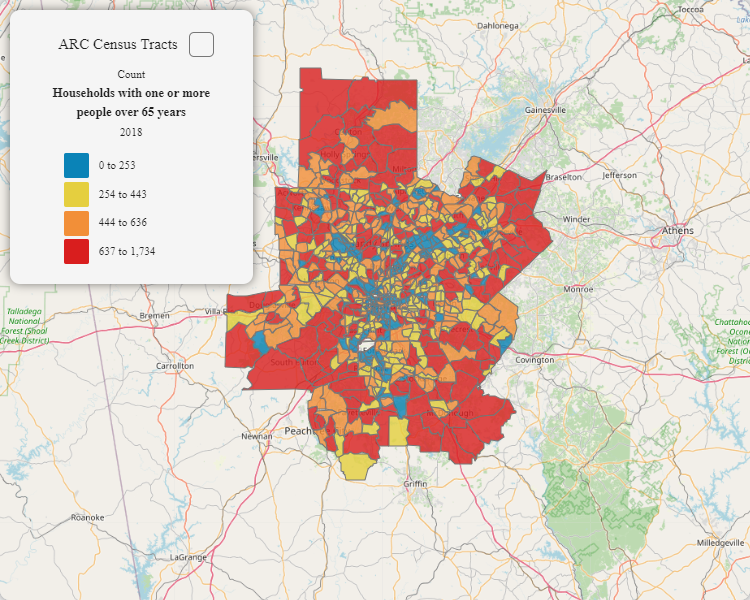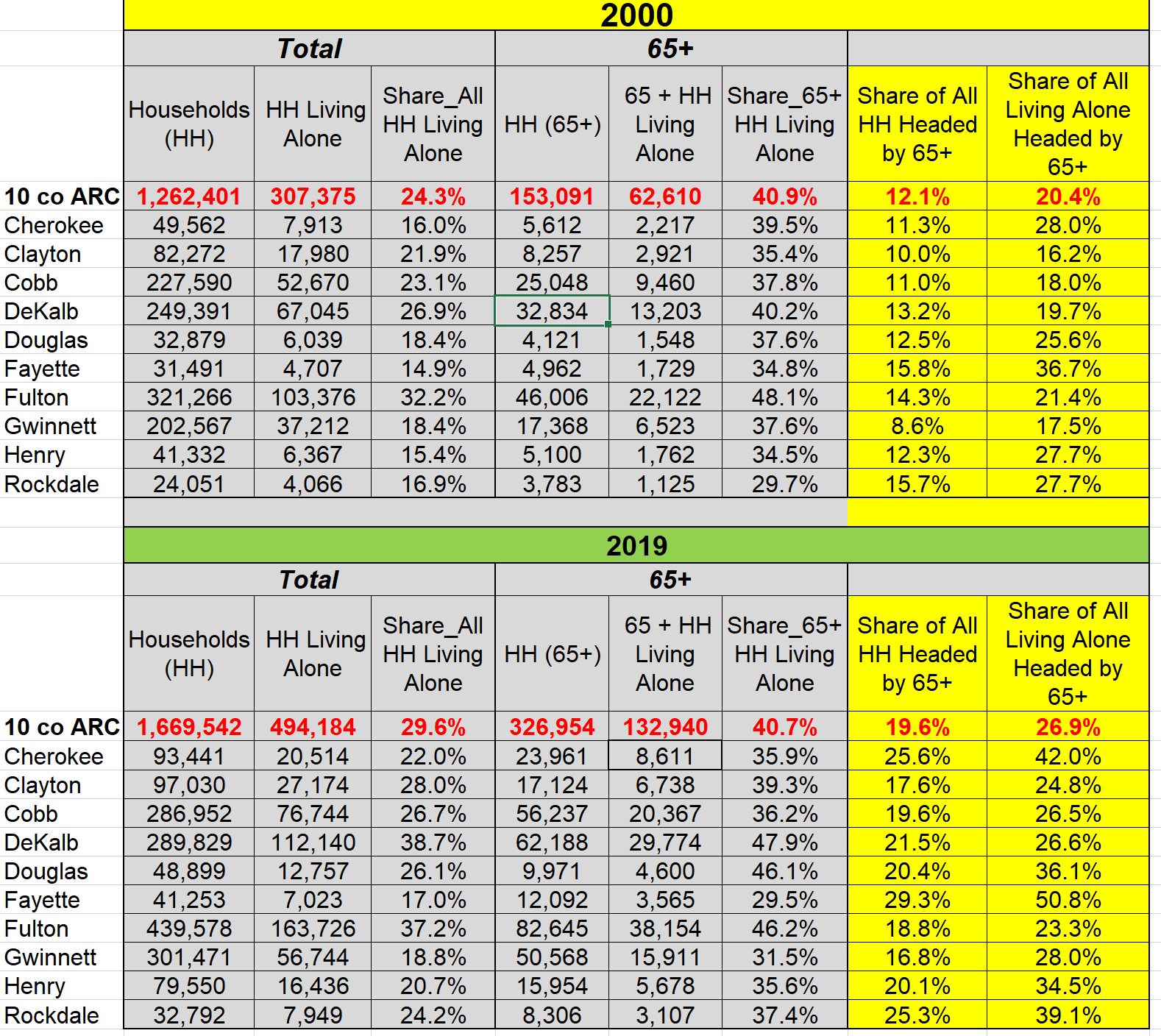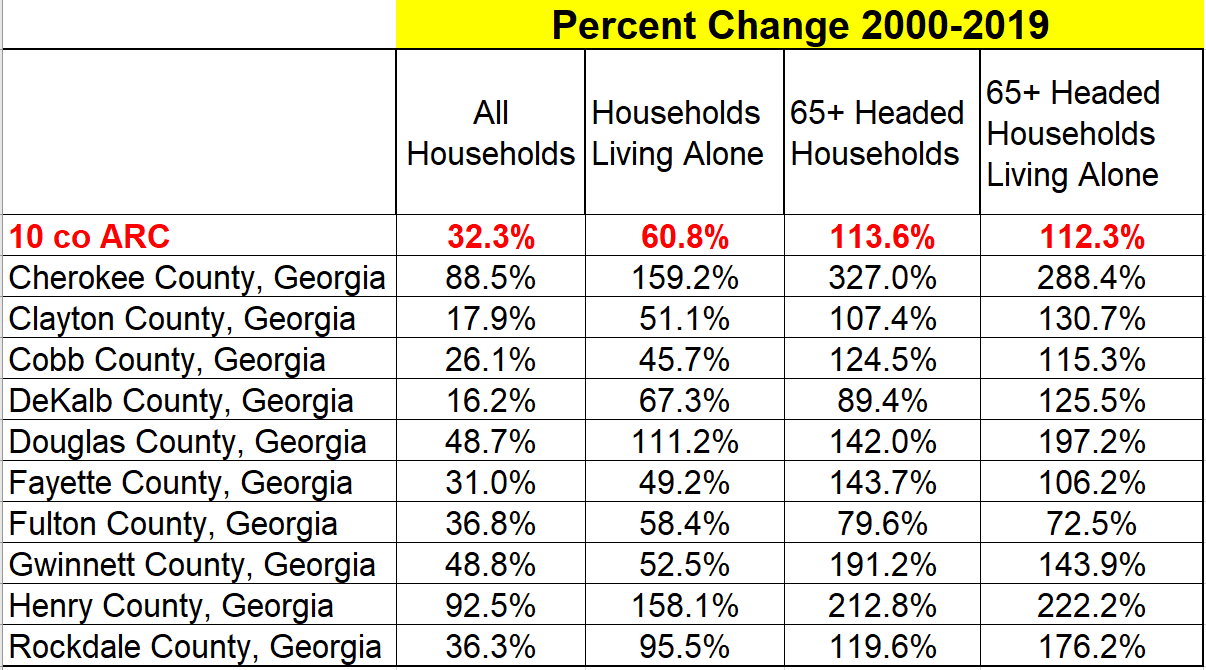While any time is a good time to look at our region’s demographics, May is Older Americans Month, providing us with the perfect opportunity to shine a spotlight on our 65+ residents and the unique circumstances, trends and opportunities they experience in Metro Atlanta. The focus of this post is the rather stunning increase (read on, you’ll see) in seniors living alone, across the 10-county ARC region as a whole and in almost all individual counties. First, some maps to set the stage for a few of those dense tables we like to include to raise the information bar (we hope and trust, that is).
Where are our seniors? Map 1 shows they’re pretty much everywhere, though there are pockets of less concentration along I-85, I-75, and north of I-20. Not all of these households are necessarily headed by seniors, though. Of more interest, and likely of more concern for planning, is Map 2’s illustration of the dispersion of householders 65+ that are living alone. These more isolated seniors are going to be more likely to need help accessing services. A caveat, however: Map 2 shows percentages of all households that are households with a 65+ aged person living alone (and the bottom three ranges do represent fairly small percentage shares).
Map 1: Number of Households with One or More Person 65 Years or Over (Source: US Census via DataNexus)

Map 2: Share of All Householders 65+ and Living Alone (Source: US Census via DataNexus)

Table 1 below presents household data by county (and the 10-county region) for two points in time: 2000 and 2019. Taking a look at the most current data first—there are over 132,000 households headed by persons 65+ that are living alone, out of 326,000 total households headed by those aged 65 and up. So nearly 41 percent of all of our senior-headed households are headed by someone 65+ living alone.
While seniors head almost 1 in 5 of all households in the 10-county region, they head nearly 3 in 10 of all households in which the householder is living alone. There is some notable variation at the county level, e.g. in Fayette, 65+ residents headed nearly half of all households in which the householder is living alone, and nearly 3 in 10 of all households; conversely, in the core county of Fulton with a higher number of young persons living alone, less than 1 in 4 households headed by a person living alone are headed by a households aged 65 or over.
Table 2 summarizes the dramatic increase in 65+ households (of all types, really) that has occurred since 2000. Overall, the number of households in our region increased by a third over the nearly two decades, but households headed by those aged 65+ have more than doubled over the same period. Households headed by a senior have more than doubled in every county except the more developed core counties of DeKalb and Fulton—and the number of 65+ householders living alone doubled in every county but Fulton.
Table 1: Households by Age of Householder and Household Type, 2000-2019 (Source: Social Explorer, Analysis by ARC Research & Analytics)

Table 2: Percent Change in Households by Age of Householder and Household Type, 2000-2019 (Source: Social Explorer, Analysis by ARC Research & Analytics)

The trend of adults age 65 and older living alone is more common among wealthier countries, with the Pew Research Center citing fewer children, longer life expectancies, cultural differences and government benefits for aging populations as driving reasons behind the phenomenon. Just because this is a phenomenon of wealthier economies, however, does not mean that seniors living alone are members of an elite class: While poverty rates among older Americans generally is lower than for the population at large, it is higher among those age 65 and older who live alone than it is for those who live with others, especially women.
Aging in place is the preference for many, many seniors and those approaching 65, and it comes with a host of policy implications especially as it pertains to older adults who live alone. For instance, those in this age group tend to need more assistance with household chores, self care and basic activities like running errands, and housing affordability is a pointed issue for those living alone. Providing adequate services also brings with it a host of land use and transportation best practices that can improve the lives of all older Americans aging in place, and dramatically so for those living alone.

